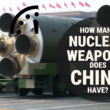In his contribution to the first round of this debate on the desirability and feasibility of developing non-contagious biological weapons as “safer” alternatives to nuclear weapons, Seth Baum defends the intellectual justification for his project on moral and humanitarian grounds. He concedes, however, that he “could have done more research on my own before publishing.” Baum’s research does leave a lot to be desired. For example, in his article in Contemporary Security Policy on which his original Bulletin of the Atomic Scientists column was based, Baum cites the toxin ricin as a suitable candidate for a strategic biological deterrent. While on paper ricin is attractive because of its high toxicity and ease of production, the toxin has failed miserably as a weapon. Several countries, including the United States, United Kingdom, and Iraq have explored the possibility of using ricin as a weapon before abandoning the toxin. According to the Organization for the Prohibition of Chemical Weapons, “Ricin is not known to have been used as a military weapon so its effectiveness as a chemical/biological warfare agent is unproven.” Ricin then is a strange choice to replace the most powerful weapon ever invented. The fundamental flaw in Baum’s column and article, however, is not so much his poor research, but the absence of analytical rigor in assessing the deterrent utility of biological weapons compared to nuclear weapons.
In his column and article, Baum lays out nine technical and political criteria for a weapon that could provide “winter-safe deterrence.” Baum’s ideal deterrent must be able to inflict a level of destruction to people or infrastructure equivalent to that of nuclear weapons, be able to survive a first strike, cause only local effects, be public, not be susceptible to significant countermeasures, not pose a significant proliferation risk, not undermine the geopolitical standing of the nuclear weapon states, not destabilize international security, and be politically acceptable. Non-contagious biological weapons fail to meet most of the criteria he described for an "ideal" deterrent. The only criterion that biological weapons easily meet is being able to survive a first-strike, since this depends more on the type, deployment mode, and alert status of the delivery system than the nature of the payload itself. On all of Baum’s other criteria, biological weapons are highly problematic, if not outright failures.
Could biological weapons cause mass casualties on par with those of nuclear weapons? Sonia Ben Ouagrham-Gormley and I already explained in our previous contributions to this debate that the answer is no, due to the high degree of uncertainty associated with the effectiveness of biological weapons and the availability of defenses against them. As Martin Furmanski pointed out, models used to demonstrate the potential of biological weapons to cause casualties at the same scale as nuclear weapons are “based on a number of important but undisclosed technical assumptions and typically portray a 'most damaging case' scenario.” Far from being an “absolute” weapon capable of causing predictably massive levels of damage in a reliable way, the effects of biological weapons are highly contingent on the specific characteristics of the agent being disseminated, meteorological factors, the health status of the targeted population, and the level of preparedness of the defender.
Could biological weapons provide a visible deterrent against which there are no significant defenses? We all know from Dr. Strangelove that “the whole point of the doomsday machine is lost if you keep it a secret.” Baum does not analyze the ability of biological weapons to meet this criterion, but as I explained in my previous contribution to this debate, states have strong normative, legal, and strategic reasons to keep their biological weapons programs secret. Since Baum is postulating a world where these normative and international legal restraints are no longer applicable, it is important to understand that the strategic motivations for secrecy will remain. The crux of the matter is that since there are effective defenses available against biological weapons, a potential attacker must keep its capabilities secret in order to retain the element of surprise and catch a defender unprepared. In his article, Baum acknowledges that the availability of defenses such as medical countermeasures and air-filtering systems on buildings are a “serious drawback” to the use of biological weapons as a deterrent. He also notes that this drawback could be reduced by a state remaining ambiguous about the types of biological weapons it has, but this would “also reduce the credibility of the deterrent.” Baum’s solution to overcoming the interconnected obstacles of defenses and secrecy is that unspecified advances in biotechnology might allow the development of biological weapons for which there are no defenses. There is certainly the potential for states to develop more lethal biological weapons, but advances in biotechnology also enable improvements in diagnostic tests, sensors, biosurveillance systems, and medical countermeasures which could improve a defender’s chances against even a genetically-engineered threat. Physics favors deterrence; biology doesn’t.
What effects would biological weapons have on geopolitics, international security, and proliferation? On all of these criteria, Baum’s own article provides evidence that the development of biological weapons by the world’s major powers would be detrimental to peace and stability. Since Baum acknowledges that biological weapons are better-suited for first-strike attacks than for retaliation, “the net effect is to destabilize the geopolitical order” and increase the risk of war. While Gigi Kwik Gronvall and Sonia Ben Ouagrham-Gormley disagree on exactly how easy it is for states to develop biological weapons, both would no doubt agree with Baum that biological weapons “present a much greater proliferation risk than nuclear weapons.” Baum does not reconcile the contradiction between the nuclear weapon states wanting to preserve their privileged position within the international community and shifting their deterrent strategies to a more widely available technology that could be used by weaker states to deter stronger ones. Furthermore, in a world where biological weapons are the foundation of deterrence, states will engage in a perpetual biotechnology arms race, constantly seeking an offensive or defensive advantage over their rivals. Such a situation would not only be destabilizing, but also have a major adverse impact on research in the life sciences and the peaceful applications of biotechnology.
Finally, do biological weapons represent a politically acceptable weapon? Again, Baum’s own article argues they are not. He writes, “The Biological and Chemical Weapons Conventions must be considered among the greatest successes of the international community.” Since I have already noted that Baum recognizes the severe limitations that plague biological weapons in a deterrent role, it is difficult to understand how he judges the purported benefits of launching a new biological weapons arms race outweighs the costs of overturning 40 years of work to prevent the proliferation of these weapons.
Perhaps the most disturbing aspect of Baum’s work is that his own analysis does not support his conclusion that non-contagious biological weapons could be a suitable replacement for nuclear weapons. Not only does Baum not provide any evidence that biological weapons possess the necessary characteristics to serve as strategic deterrents, he cites several features that would undercut their ability to function in that role. In the end, the potential lethality of biological weapons appears to be the only factor that Baum considers necessary and sufficient for these weapons to serve as “the poor man’s atomic bomb.” In defending his recommendation to replace nuclear weapons with biological weapons as a means of avoiding nuclear winter, Baum claims “the stakes are simply too high not to make hard choices.” Given the radical nature of Baum’s policy recommendations, the stakes are too high for scholars and publishers not to ensure that their research is backed up by solid evidence and rigorous analysis.
Share: [addthis tool="addthis_inline_share_toolbox"]














